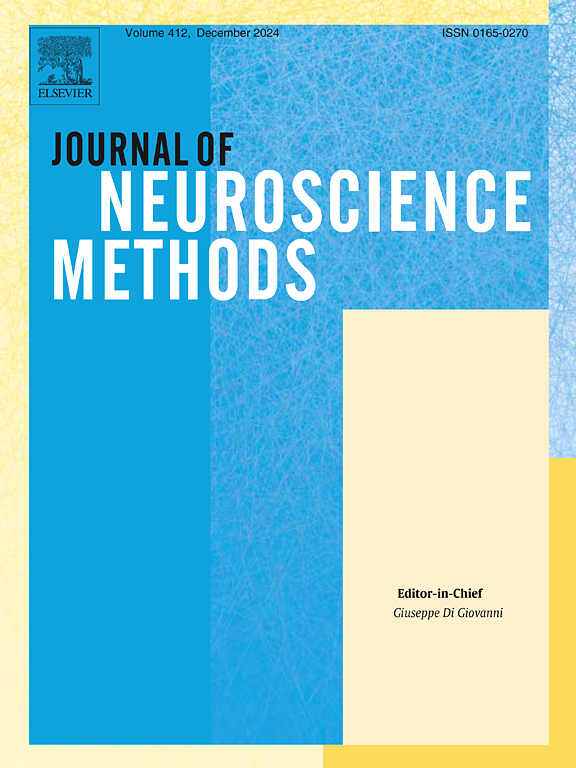Does intra-epidermal electrical stimulation activate mechano- and thermo-nociceptors? A discrimination approach
IF 2.7
4区 医学
Q2 BIOCHEMICAL RESEARCH METHODS
引用次数: 0
Abstract
Background
Objective laboratory tests are needed to diagnose lesions within the nociceptive system accurately. One approach is assessing pain-related evoked potentials (PREPs) in response to intra-epidermal electrical stimulation (IES). In this context, peripheral characterization of the specificity of nociceptor activation with IES is needed.
New Method
As IES directly depolarizes free nerve endings, it might allow a more comprehensive nociceptor activation than classical contact heat stimulation. Hence, this study aimed to investigate whether mechano-nociceptors are activated by IES. To test this hypothesis, a heat pain model was used to assess whether IES would show comparable pain hypersensitivity in the experimentally-induced area of secondary mechanical hyperalgesia (SMH), as known for pinprick but not for contact heat stimuli. Pain ratings and PREPs were recorded in response to 15 contact heat and pinprick stimuli as well as IES applied to the volar forearm before (PRE) and after (POST) a heat pain model inducing an area of SMH (EXP) or a control model (CTRL).
Results and Comparison with Existing Methods
All 24 participants (25.5 ± 4.7 y, 10 f/14 m) presented with SMH in POST-EXP condition. Pain ratings were significantly increased in EXP versus CTRL for IES (p = 0.016) and pinprick (p = 0.006) but not for contact heat (p = 0.683). PREP NP-amplitude between EXP and CTRL was only increased in response to pinprick (p = 0.027), but not to IES (p = 0.547) and contact heat stimuli (p = 0.070).
Conclusions
Psychophysical assessments suggest mechano-nociceptor activation by IES, while PREPs do not support this assumption, indicating the predominant activation of thermo-nociceptors by IES.
表皮内电刺激能激活机械和热痛觉感受器吗?一种歧视方法。
背景:需要客观的实验室检查来准确诊断伤害感觉系统内的病变。一种方法是评估表皮内电刺激(IES)的疼痛相关诱发电位(PREPs)。在这种情况下,需要用IES对伤害感受器激活的特异性进行外周表征。新方法:由于IES直接使自由神经末梢去极化,它可能比传统的接触热刺激允许更全面的伤害感受器激活。因此,本研究旨在探讨机械性伤害感受器是否被IES激活。为了验证这一假设,研究人员使用热痛模型来评估IES是否会在实验诱导的继发性机械痛觉过敏(SMH)区域表现出类似的疼痛超敏反应,SMH是针刺而不是接触性热刺激。在热痛模型诱导SMH区(EXP)或对照模型(CTRL)之前(PRE)和之后(POST),记录15次接触热和针刺刺激以及施加于前臂掌侧的IES的疼痛评分和PREPs。结果与现有方法比较:24名受试者(25.5 ± 4.7 y, 10 f/14 m)均出现后实验条件下的SMH。与对照组相比,实验组的疼痛评分在IES (p = 0.016)和针刺(p = 0.006)时显著增加,但在接触热(p = 0.683)时无显著增加。EXP和CTRL之间的PREP np振幅仅对针刺(p = 0.027)有增加,而对IES (p = 0.547)和接触热刺激(p = 0.070)没有增加。结论:心理物理评估表明机械性伤害感受器被IES激活,而PREPs不支持这一假设,表明热伤害感受器主要被IES激活。
本文章由计算机程序翻译,如有差异,请以英文原文为准。
求助全文
约1分钟内获得全文
求助全文
来源期刊

Journal of Neuroscience Methods
医学-神经科学
CiteScore
7.10
自引率
3.30%
发文量
226
审稿时长
52 days
期刊介绍:
The Journal of Neuroscience Methods publishes papers that describe new methods that are specifically for neuroscience research conducted in invertebrates, vertebrates or in man. Major methodological improvements or important refinements of established neuroscience methods are also considered for publication. The Journal''s Scope includes all aspects of contemporary neuroscience research, including anatomical, behavioural, biochemical, cellular, computational, molecular, invasive and non-invasive imaging, optogenetic, and physiological research investigations.
 求助内容:
求助内容: 应助结果提醒方式:
应助结果提醒方式:


